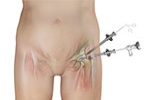What You Need to Know About Hip Replacement Surgery
Hip replacement is one of the most successful joint replacement surgeries performed in the US today. At the American Hip Institute, hip replacement is routinely performed as an outpatient procedure with greater than 99% accuracy in implant placement.









